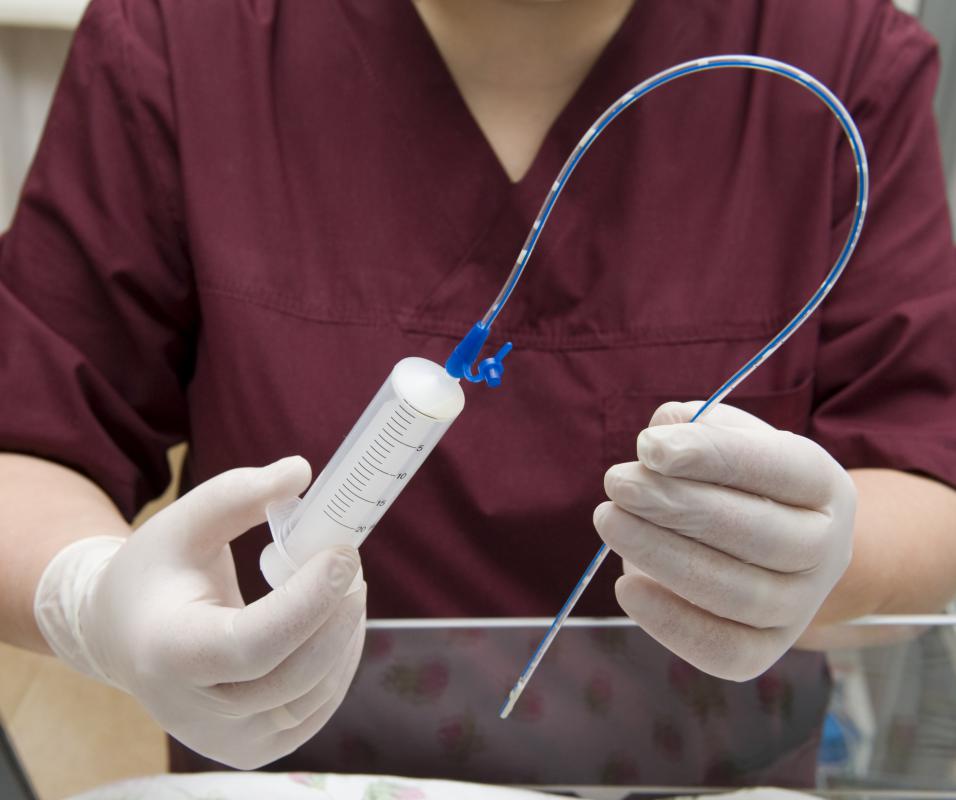At TheHealthBoard, we're committed to delivering accurate, trustworthy information. Our expert-authored content is rigorously fact-checked and sourced from credible authorities. Discover how we uphold the highest standards in providing you with reliable knowledge.
What is a Nasal Tube?
A nasal tube is a plastic feeding tube that is inserted through the nose and run down through the throat, into the stomach. A feeding tube is a medical device that is inserted into the patient’s digestive tract in order to give liquid nutrients and medicines to the body when the patient cannot eat normally. Impediments to natural ingestion and digestion commonly include oral cancer, surgery, injury, severe eating disorders, and any trauma or disorder that negatively impacts the function of the digestive system. The tube can also be used for diagnostic purposes.
The nasal tube, also called the nasogastric tube or NG tube, avoids the mouth and throat and deposits the liquid nutrition and medicine directly into the stomach. Liquid may be moved down the tube with the aid of gravity or with a pump. The NG tube is typically used when the patient only needs short-term intubation. If the patient needs longer term intubation, the doctor may prefer to insert a tube directly into the stomach or into the small intestine.

A nasal tube can be used for feeding, diagnostic, and therapeutic purposes. If the patient’s mouth or throat is compromised due to a disease, such as esophageal cancer or a nervous disorder which prevents normal swallowing, a tube may be needed to get food and medicine past this damaged region of the body. Patients with severe anorexia nervosa, an eating disorder, may also have difficulty maintaining or regaining a healthy body weight on their own, making a nasal tube necessary for recovery.

An NG tube can also be used therapeutically to drain unwanted materials from the stomach through a process known as gastric aspiration. Secretions from the stomach, poisonous ingested substances, and swallowed air can be sucked out of the stomach through the tube, providing the patient relief and preventing vomiting. Diagnostically, a nasal tube can be used to examine the contents of the stomach and assess internal bleeding. The NG tube can also assist in diagnostic imaging by providing a contrast to other tissues in the body.

When inserting a nasal tube, the patient may be numbed with a local anesthetic. The patient and the tube are measured to ensure that the tube will reach the correct depth into the stomach. The tube is then inserted into through the nostril and pushed through the nasal passageway, past the pharynx in the throat, through the esophagus, and into the stomach. The physician should be careful not to accidentally push the tube into the airway, instead of down the digestive tract. Tests will sometimes be performed to ensure correct placement.

While a nasal tube may produce some discomfort, it should not be painful. Nasogastric intubation should not proceed if the patient has trauma to the middle of the face or has had recent nasal surgery. Doctors may also advise against a nasal tube if the patient has a coagulation, or blood clotting, abnormality, an obstructed airway or esophagus, a fracture to the skull, or a history of gastric bypass surgery. If the stomach is unsuitable for digestion, the doctor may choose to insert a feeding tube into the jejunum, or middle segment of the small intestine, instead.
AS FEATURED ON:
AS FEATURED ON:
















Discuss this Article
Post your comments